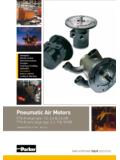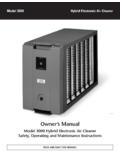Transcription of Product Name: R134a Refrigerant - Weitron Inc.
1 Safety Data S heet I nformation Section 1. CHEMICAL Product SECTION Product name : Date Prepared: R134a Refrigerant 05-2015 Manufactur er : Weitron , In c. 801 Pencader Dr. Newark, DE 19702 USA PH: (800)-398-3816 PH: (302)-455-6655 Fax: (302)-455-6656 Section 2. HAZARDS IDENTIFICATION Product HAZARD CATEGORY: Gases under pr essure. L iquefied Gas LABEL CONTENT: Pictogram SIGNAL WORD: WARNING HAZARDOUS WARNINGS: Contains gas under pr essure; may explode if heated. HAZARDOUS PREVENTION MEASURES: Protect from sunlight. Store in a well-ventilated place. OTHER HAZARDS: Misuse or intentional inhalation abuse may lead to death without warning. Vapor is heavier than air and can cause suffocation by reducing oxygen available for br eathing. Rapid evaporation of the liquid may cause frostbi te. Weitron branded products that are considered and labeled Consumer Commodities are exempt from GHS labeling guidelines when used in the workplace in the same way and the same frequency of use as a consumer would use the Product .
2 Section 3. COMPOSITION/INFORMATION ON INGREDIENTS This pr oduct contains no known hazardous materials as defined by the OSHA Hazard Communication Standard 29 CFR CAS # Description % 811-97-2 1,1,1,2-Tetrafluoroethane 100 % Emergency Overview: Contents under pr essure. Frostbi te-li ke effects may occur if the liquid or escaping vapors contact the eyes or skin. In halation overexposure may cause: Central nervous system depr ession with dizziness, confusion, loss of coordination, dr owsiness, unconsciousness or death. Suffocation if air is displaced by vapors. Pot ential Health E ffects: Eyes: Frostbi te-li ke effects may occur if the liquid or escaping vapors contact the eyes. Skin: Frostbi te-li ke effects may occur if the liquid or escaping vapors contact the skin. In halation: In halation overexposure may cause: Central nervous system depression with di zziness, confusion, loss of coordination, drowsin ess, unconsciousness or death.
3 Suffocation, if air is di splaced by vapors. Nausea and diarrhea are possible. Ingestion: Carcinogeni ci ty: No known c ancer hazards. HMIS Classifi cation: LEL: None Section 4. FIRST AID MEASURES Eye Contact: In case of contact, immedi ately flush eyes with plenty of water for at least 15 minutes. Get medical attention immediately. Skin Contact: Wash affe cted area immediately with large amounts of soap or water for 15 minutes. Remove contaminated clothing and shoes, and wash before reusing. Treat affected area for frostbi te if necessary by gently warming. May irritate skin. If irritation continues contact Phys ician. In halation: If in haled, immediately remove to area with fresh air. If not breathi ng give artificial respi ration. If br eathi ng is difficul t give oxygen. Contact Ingestion: Is not considered a potential route of exposure. Advice to Physician Because of the possible di st ur bances of cardiac rhythm, catecholamine drugs, s uch as epinephrine, shoul d be used with caution and onl y in situations of emergency life support.
4 Section 5. FI RE F IGHTING MEASURES Flash Point: Does not flash Flammable limits in Air Health 1 Flammability 0 Reactivity 1 UEL: above 120 F. Keep in cool dr y area out of direct sunlight. None Based on ASHRAE Standard 34 with match ignition Autoignition Temperature: >750 C Extin guishing Medi a: Water, carbon dioxide, foam or dry powder. Fire & Explosion Hazards: Not flammable at ambi ent temperatur es and atmospheric pr essure. Material will become combustible when mixed with air under pr essure and exposed to ignition sources. Hazardous thermal decomposition products (Carbon oxides, Hydrogen Fluoride, Carbonyl fluoride) Fire Fighting Instructions: Contents under pressure and container may rupt ur e when exposed to hi gh temperatur e. Product may act as asphyxiate. As in any fire, wear self-contained breathi ng apparatus pr essure- demand MSHA/NIOSH (appr oved or equivalent) and ful l pr otective gear.
5 Contain runoff water. Contaminated extinguishing water must be di sposed o f in accordance with applica bl e regulations. Avoid breathi ng smoke, fumes, and decomposition products. Section 6. ACCIDENTAL RELEASE MEASURES Safeguards (Personnel) Evacuate personnel to safe areas. Ventilate area. Wear appropriate personal pr otective equipment Initial Containment Contain spilled material. Do not allow material to enter soil or surface water. Product evaporates Spill Procedures Contain spilled material. Large spillage should be dammed-off and pumped into containers. Section 7. HANDLING AND STORAGE Handling (Personnel) Do not br eathe vapors. Do not get in eyes, on skin or clothi ng. Wash hands thoroughly after handling. Wash contaminated clothing before reuse. Use appro priate personal protectiv e equipment when using material. Do not puncture or drop cans. Do not expose cans to hi gh heat or open f lame.
6 Handling (Phys ical Aspects) Avoid contact with strong oxidizing agents. Avoid contact with eyes and skin. Keep away from children. Storage Precautions Pr ot ect containers from phys ical damage. Do not Punctur e, incinerate or store cans Section 8. EXPOSURE CONTROL/PERSONAL PROTECTION Engineering Controls: Good general ventilation shoul d be sufficient under normal use conditions. Eye/ Face Prot ective Requirements: Wear safety glasses, s plash goggles or face shield. Where contact with t hi s material is likely, eye protection is recommended. Skin Protection: Wear protective gloves to minimize skin contamination. When prolonged or frequently repeated contact coul d occur, use protective clothing impervious to t hi s material. Respiratory Protection: Under normal use conditions, with adequate ventilation, no special handling equipment is required. Miscellaneous Use good personal hygiene practices; limit exposure to pr oduct whenever possible to minimize clean-up.
7 Stability Exposure Guidelines Exposure Limit Values 1,1,1,2-Tetrafluoroethane AEL 1,000 ppm 8 & 12 hr . TWA AEL is the Accept able Exposure Limit determined by Dupont Section 9. PHYSIC AL A ND CHEMICAL PROPERTIES Form: Color: Odor: Boiling Point: Solubility in Water: Vapor Pressure: Vapor Gravity: Specific Gravity: Liqui d Density: PH: Volatile Organic Compounds (VOC) Liquefied Gas Colorless Slight ethereal odor C ( F) at 77oF (25oC) psia @ 70 F Not Determined at 77oF (25oC) g/cm3 @ 25oC <7 Not Determined Flash point & additi onal flammability data found in section 5. Section 10. STABILITY AND REACTIVITY Thi s compound is stable at ambi ent conditions. Polymerization Hazardous polymerization will not occur Conditions to avoid Do not mix with air above atmospheric pr essure or oxygen. Do not puncture, incinerate or store cans above 120 F. Keep in cool dry area out of direct sunlight.
8 Incompatibility with other materials Avoid contact with strong oxidizing agents. Incompatible with alkali or alkaline earth metals powdered aluminum, Zink, etc. Decomposition Avoid hi gh temperatures or open flames whi ch can decompose material forming hydr ofluoric acid and possibl y carbonyl fluoride. Aqua Toxicity Section 11. Dermal Oral In halation 4 h LC50 In halation LOAEC Skin Irritation TOXICOLOGY INFORMATION : not applicable : not applicable : 567000ppm, rat : 75000ppm, dog : slight irritation, rabbit Not expected to cause skin irritation based on expert review of pr operties of the substance No skin irritation, human : slight irritation, rabbit Not expected to cause skin irritation based on expert review of pr operties of the substance No skin irritation, human : Did not cause sensiti zation on laboratory animals, guinea pig Not expected to cause sensitization based on expert review of the pr operties of the substance Did not cause sensitization on humans Eye I rritation Skin Sensitization Repeated dose toxicity : Inhalation Rat No toxicologically significant effects were found Carcinogeni city.
9 Overall weight of evidence indi cates that the substance is not carcinogeni c An increased incidence of benign tumors was observed in laboratory animals : Did no cause genetic damage in animals Did not cause genetic damage in cul tur ed mammalian cells Did not cause genetic damage in cul tur ed bacterial cells : Animal testing showed no reproductive toxicity : Animal testing showed effects on embryo-fetal development at level equal to or above those cause maternal toxicity : Cardiac sensitization threshold limit: 312975 mg/m3 Mutageni city Reproductive toxicity Teratogenicity Further information Section 12. ECOLOGICAL INFORMATION 96 h LC50 mg/L 72 h EC50 Section 16 OTHER INFORMATION : Oncohynchus mykiss (rainbow trout) 450 : Al gae >118 mg/L Information based on data obtained from similar substances : Daphnia magna (water flea) 980 mg/L 48 h EC50 Section 13. DISPOSAL CONSIDERATIONS Waste Disposal Can be used after re-conditioning.
10 Recover by di stillation or remove to a permitted waste di sposal facility. Compl y with Federal, State, and local regulations Environmental Hazards Empty Pressure Vessels shoul d be retur ned to the supplier Section 14. TRANSPORTATION INFORMATION US DOT Information: Shipping name : 1,1,1,2-Tet rafluoroethane Product Label: 1,1,1,2 Tetrafluoroethane Shipping Class: UN/NA #: 3159 ICAO/IATA Shipping name : 1,1,1,2- tetrafluoroethane Shipping Class: UN/NA#: UN3159 Exceptions: Can qualify for limited quanti ty under special provisions Other information: Non-flammable IMDG Shipping name : 1,1,1,2-Tetrafluoroethane Shipping Class: UN/NA#: UN3159 Exceptions: Can qualify for limited quanti ty under special provisions Other information: Non-flammable Other Transportation Information: The Transport information may vary with the container and mode of shi pment. Section 15. REGULATORY INFORMATION Miscellaneous Information Thi s material or all of its components are listed on the Inventory of Existing Chemical Substances under the Toxic Substance Control Act (TSCA) Thi s material or all of its components are listed (or considered as having been notified) on the Eur opean Inventory of Existing Chemical Substances (EINECS) Thi s material or all of its components are listed on the Canadian Domestic Substances List (DSL) To the best of our knowledge, the information contained herein is accurate.





